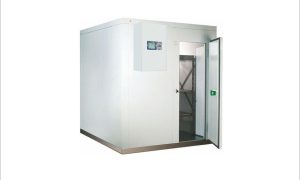The pandemic impacts 3PL, labour & safety in cold storage. Even before the pandemic, several forecasts predicted labour and driver issues and storage space shortages.
Interstate Cold Storage releases an industry report covering the ongoing impact of the pandemic on cold storage. We are now in the third year of the global pandemic. Many industries, from restaurants to retail shops, struggle with labour and product shortages. Cold storage is no different.
This report discusses the impact of the pandemic from a 3PL cold storage company’s vantage point, written by Charles Betts. It offers a first-hand account of the pandemic’s impact from the perspective of a leading frozen warehousing company. According to the report, manufacturing companies are producing frozen products at pre pandemic levels as cold storage availability has reduced, which could cause the market to tighten further. There are also challenges due to a lack of available drivers and a shortage of manufacturing and warehousing labour personnel. This has led to increased prices for temporary solutions.
The industry report is divided into three categories: economic conditions, labour shortages and safety changes in the 3PL cold storage industry.
Available Cold Storage Space
Available cold storage space had already been a pre-pandemic threat. Several industry leaders and data scientists had predicted a shortage of cold storage space that was set to reach critical mass in late 2020 to 2022 by several models. Cold Storage was (and remains) a hot industry for venture capitalists. While increasing, the number of greenfield projects was still short of the frozen segment’s growth patterns. Predictions abounded of increased rates due to a shortage of space. The pandemic, however, reduced the production capacity of several food companies. Across the board, demand for cold food outpaced production and many food companies saw “on-hand” inventories reduce to keep up with demand. In a good way, this affected available cold storage space. More companies were able to find cold storage within their service lanes in 2020 and 2021.
However, domestic food manufacturers have a common goal to get their inventory level and fill rates back to pre-covid levels. Therefore, the market is now beginning to forecast as tight again.
Driver Shortages
The ongoing shortage of available drivers and the lack of warehousing /manufacturing labour have created a real challenge for those who miss appointments and/ or have shifted loads. Before the pandemic, there were more choices to “rework a load” and find “temporary storage” near the destination for a second delivery attempt. More facilities are working with limited labour and have diminished support for these “short-term storage” needs.
Labour Shortages
Some facilities have reduced hours to consolidate labour. Finding 3rd shift labour has been very challenging since the pandemic. It cannot be overstated that the reduced labour resources negatively impact the cost of finding temporary solutions for missed appointments and shifted loads. Carriers must travel greater distances to find unscheduled services and pay higher prices for unscheduled labour, often at overtime rates.
Effect of Labour Shortages on the 3PL Cold Storage Industry
Cold Storage Capacity
The labour shortage has been profound in 3PL cold storage. Several facilities declined to bid on new customers requiring a lot of labour, despite having space. While this has been common in many industries, it has been especially prevalent in cold storage.
Handling Charges
With direct tieback to labour, handling charges will most likely surge in the coming year if not already in your area. The average dock worker’s pay has increased 20-25 percent over two years. On your annual price agreements, it would be wise to forecast your inventory and turns so that your 3PL cold storage partner can’ staff accordingly and provide any efficiencies’ to help offset handling cost/pricing resulting from your forecast.
Services Offered
Cold storages offer a wide variety of services. Some services overlap with what manufacturers may normally provide at their plants. This is by design, as they are often requested as a troubleshooting option: blast (or quick) freeze, relabeling, repacking, strapping, stamping, restacking, cross-docking, and other services are often heavily dependent on labour. Several cold storages are reducing these services and focusing the available labour on the basic core functions of receiving and shipping full pallets.
Further, a reduction in applicants means that attrition of existing staff will reduce “extra” service capabilities. Until the labor market turns around, expect further erosion of labourintensive services. In addition to these miscellaneous extra services, one core service that is becoming hard to find is case picking. Long considered a standard offering, it’s a very labour-intensive service that increases the outbound labour by up to 300-500 percent depending on the density of picks/ outbound. It also exposes the employees to the environment, who must exit their equipment to provide this service. Employee morale is more important than ever, and case picking is challenging. Overtime labour is also affected in the same way. There are fewer employees seeking overtime hours than in the pre-pandemic work climate.
Safety Changes in the 3PL Cold Storage Industry
Employee Safety
Safety has been at the forefront of all 3PL cold storage facilities. Typically, workers worked nearby, and there could be several users of MHE (material handling equipment), Scanners, keyboards, and work areas. Cold Storage has several employees who have changed work areas and environments.
Increased Sanitation
Social distancing, sanitising work areas, and material handling equipment have become necessary to protect the work environment. This has negatively impacted productivity as workers spend time managing their work areas three to four times per shift (an average of 20 minutes per shift). Sickness Policy Challenges for 3PL Cold Storage: In most industries, callouts have increased due to the close working conditions of staff in a 3PL cold storage. Many penalties for “calling out” and “unexcused” absences were lifted as a matter of safety. Overwhelmingly, on-site management has developed a cautionary stance on allowing a higher incidence of callouts. This has exacerbated labour challenges in the 3PL cold storage industry.
For more info visit. www.interstatecoldstorage. com
Cookie Consent
We use cookies to personalize your experience. By continuing to visit this website you agree to our Terms & Conditions, Privacy Policy and Cookie Policy.














